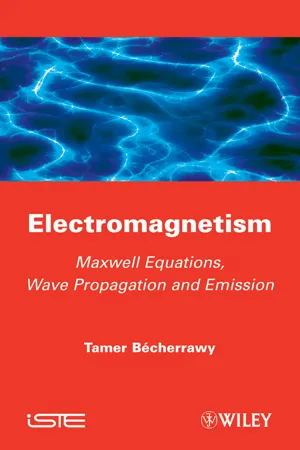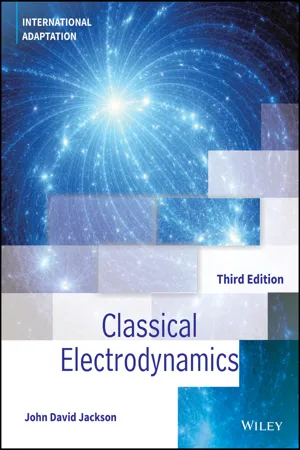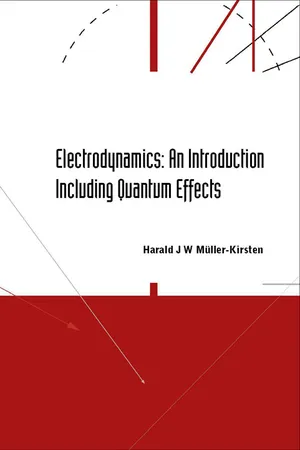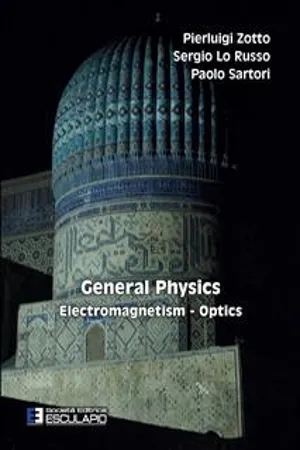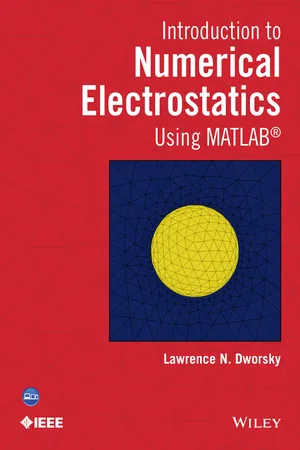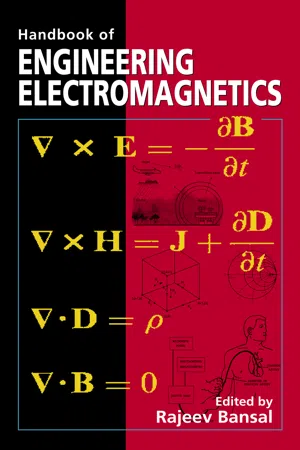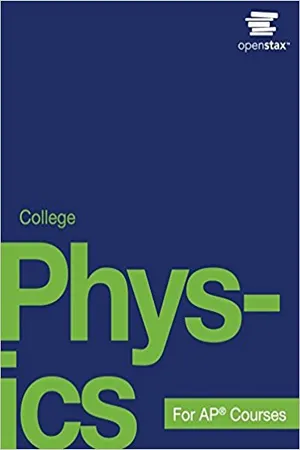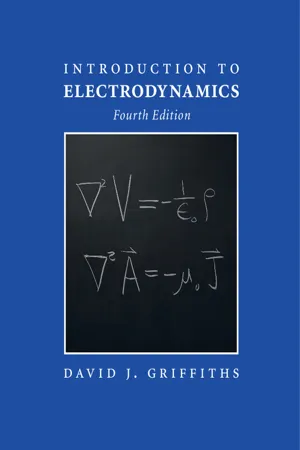Physics
Electrostatics in Vacuum
Electrostatics in vacuum refers to the study of stationary electric charges and the forces they exert in a vacuum, where there is no air or other matter. This branch of physics focuses on the behavior of electric fields and the interactions between charged particles in a vacuum environment. Understanding electrostatics in vacuum is essential for various applications in technology and engineering.
Written by Perlego with AI-assistance
Related key terms
1 of 5
11 Key excerpts on "Electrostatics in Vacuum"
- eBook - ePub
Electromagnetism
Maxwell Equations, Wave Propagation and Emission
- Tamer Becherrawy(Author)
- 2013(Publication Date)
- Wiley-ISTE(Publisher)
Chapter 2Electrostatics in Vacuum
The interaction of electric charges, as expressed by Coulomb force, is formulated according to the Newtonian concept of action-at-a-distance: if a charge q′ is produced at r′ at a time t′, a charge q located at r feels the action of q′ instantaneously, whatever the distance |r − r′| and the medium that separates the charges. The concept of field was developed by Faraday, Maxwell, Lorentz, Einstein, and many others. In modern physics, all interactions are conceived as local, i.e. involving quantities defined at the same point r and at the same time t. Fields are physical entities that are endowed with energy, momentum, etc., and they may propagate with some finite speed as waves. Furthermore, in quantum theory, the same objects (electrons for instance) have both particle and wave properties.In this chapter, we introduce the concepts of electric field and potential, we derive the fundamental equations of Electrostatics in Vacuum, and we discuss some of their properties and the concept of electrostatic energy.2.1. Electric forces and fieldIn a famous experiment, Coulomb used a torsion balance to measure the force of interaction of electric charges. He verified that a small charge q1 acts on a small charge q2 situated at a distance r with a force FE = Ko q1 q2 /r2 oriented along the line joining the charges. This force is repulsive between like charges and attractive between unlike charges. It has a similar mathematical form to Newton's law of universal gravitation To specify both the direction and the magnitude, we write[2.1 ]Coulomb's force obeys the principle of action and reaction. Ko is a constant that depends on the adopted unit of charge. Using the coulomb (C) as the unit of charge and the Heaviside or rationalized system, we write[2.2]εo is the permittivity of vacuum. The factor 4π is introduced to simplify the writing of equations. The electric force is much more intense than the gravitational force and the coulomb is an enormous charge on the human scale: electric sparks are produced by less than one microcoulomb and rubbing produces a charge of the order of the nanocoulomb per square centimeter - eBook - PDF
- John David Jackson(Author)
- 2021(Publication Date)
- Wiley(Publisher)
We begin our discussion of electrodynamics with the subject of electrostatics—phenomena involving time-independent distributions of charge and fields. For most readers this material is in the nature of a review. In this chapter especially we do not elaborate significantly. We intro- duce concepts and definitions that are important for later discussion and present some essential mathematical apparatus. In subsequent chapters the mathematical techniques are developed and applied. One point of physics should be mentioned. Historically, electrostatics developed as a science of macroscopic phenomena. As indicated at the end of the Introduction, such idealizations as point charges or electric fields at a point must be viewed as mathematical constructs that permit a description of the phenomena at the macroscopic level, but that may fail to have meaning micro- scopically. 1.1 | COULOMB’S LAW All of electrostatics stems from the quantitative statement of Coulomb’s law concerning the force acting between charged bodies at rest with respect to each other. Coulomb, in an impressive series CHAPTER 1 Introduction to Electrostatics Chapter Contents 1.1 Coulomb’s Law 1.2 Electric Field 1.3 Gauss’s Law 1.4 Differential Form of Gauss’s Law 1.5 Another Equation of Electrostatics and the Scalar Potential 1.6 Surface Distributions of Charges and Dipoles; Discontinuities in the Electric Field and Potential 1.7 Poisson and Laplace Equations 1.8 Green’s Theorem 1.9 Uniqueness of the Solution with Dirichlet or Neumann Boundary Conditions 1.10 Formal Solution of Electrostatic Boundary-Value Problem with Green Function 1.11 Electrostatic Potential Energy and Energy Density; Capacitance - eBook - PDF
- Bhag Singh Guru, Hüseyin R. Hiziroglu(Authors)
- 2009(Publication Date)
- Cambridge University Press(Publisher)
3 Electrostatics 3.1 Introduction ................................. Armed with the necessary tools of vector operations and vector calculus, we are now ready to explore electromagnetic field theory. In this chapter, we study static electric fields (electrostatics), due to charges at rest. A charge can be either concentrated at a point or distributed in some fashion. In any case, the charge is assumed to be constant in time. We begin our discussion by stating Coulomb’s law of electrostatic force between two point charges fixed in space. We define the electric field intensity as the force per unit charge. We then want to establish that a) The electric field intensity is irrotational or conservative, and b) The work done in moving a charge from one point to another in an electrostatic field is independent of the path taken and depends only upon the endpoints of the path. We will express the electric field intensity in terms of electric potential and deduce an expression for the energy required to move a charge from one location to another in an electrostatic field. We will also explore the influence of the medium on electrostatic fields and define bound charge densities ; examine several methods (Gauss’s law, Poisson’s and Laplace’s equations, method of images) of solving electrostatic field problems ; and develop the concept of ca-pacitance and obtain an equation for the energy stored in a capacitor. Some aspects of electrostatic fields discussed in this chapter may appear to be a repetition of what you have already studied in physics. Some repetition is necessary, not only to maintain a continuous link from one section to another, but also to motivate the learning process. We are convinced that a discerning student will find this repetition helpful. 3.2 Coulomb’s law ................................. Electrostatics is based upon the quantitative and experimentally veri-fiable statement of Coulomb’s law pertaining to the electric force that 70 - Harald J W M??ller-Kirsten(Author)
- 2004(Publication Date)
- WSPC(Publisher)
Chapter 2 Electrostatics - Basic Aspects 2.1 Introductory Remarks In this chapter the Coulomb law is introduced, and various static conse- quences are investigated, such as electrical screening and diverse applica- tions. The latter require also the introduction of essential mathematics, in particular that of the delta distribution. 2.2 The Coulomb Law Electrostatics is the theory of static charges, which means that moving charges, i.e. currents, are not considered. The fundamental phenomeno- logical law which is the basis of electrostatics is Coulomb’s law, which deter- mines the force acting between two point charges q1, q2 and which in vacuum is given by q1q2 r. F12 = k- 7-3 Here r = r l - r2 is the vectorial separation of the charges qi at positions ri. k is the constant fixed by the choice of units. In the ISU, as explained in Chapter 1, 1 k=- in vacuum. The force is given in newtons (N), the charge in coulombs (C) and the separation in meters (m). The electric field strength E(r) at a point r as in Fig. 2.1 is defined as the Coulomb force acting on a unit charge (+1C) 4TEo 9 10 CHAPTER 2. ELECTROSTATICS - BASIC ASPECTS at this point, i.e. In the ISU or MKSA-system of units the electric field strength is given in units of N/C or V/m. In the Gaussian system the charge is given in stat- coulombs, the distance in cm, the force in dynes, and the electric field strength in statvolt/cm (1 C = 3 x lo9 statcoulombs, 1 statcoulomb = 10 e.s.u.; 1 newton = lo5 dynes). Fig. 2.1 Point charges q1 and $1. It should be remembered that a charge q can be positive or negative. Con- ventionally electric lines of force are drawn as leaving positive charges and directed towards negative charges. In this sense positive charges are regarded as sources of the electric fields and negative charges as sinks. One distinguishes between discrete charge distributions (charges at dis- tinct points) and continuous charge distributions (charges spread over spatial domains).- eBook - PDF
- Pierluigi Zotto, Sergio Lo Russo, Paolo Sartori(Authors)
- 2022(Publication Date)
- Società Editrice Esculapio(Publisher)
Electrostatic Field and Electrostatic Potential 2.1 Introduction Electrostatic force, as defined by Coulomb’s law, is formally identical to gravitational force, as expressed by Newton’s law, with the mere substitution of the mass of the bodies with their charge. It is therefore possible to define an electrostatic field, in full analogy with respect to the gravitational field definition, as the region of the space where an electrostatic force is exerted and it is also possible to associate an electrostatic potential with each point of this region. The general properties of an electrostatic force and of a gravitational force are obviously the same. 2.2 Electrostatic field Consider a point-like particle of mass m, charged with an amount of electric charge q, which lies in an empty space, that is in a region of the space where all the other bodies are placed at a very large distance from the selected body. Bring from infinite distance another point-like body which carries a charge ′ q (usually called test-charge) into this empty space and measure the intensity and the direction of the force being exerted between the two charges q and ′ q in each point P which belongs to this space. This operation draws a map of the electrostatic force vector F = 1 4πε 0 q ′ q r 2 u r , where u r is the unit vector of a polar coordinate reference system whose origin is chosen in point O, where body m is placed. Such a map is correct only if the size of body m with respect to the distance from point P, where charge ′ q is placed, is truly negligible, because electrostatic induction causes charge displacement both inside the body and on its surface. The map is therefore exact in the whole space only if the charge ′ q has a negligible value and therefore it cannot generate any relevant displacement of charge q which modifies how it is distributed in a body. - Lawrence N. Dworsky(Author)
- 2014(Publication Date)
- Wiley-IEEE Press(Publisher)
1 A Review of Basic ElectrostaticsElectric and magnetic phenomena, including electromagnetic wave propagation, are described by Maxwell’s equations.1 When nothing is changing with time, that is, when all derivatives with respect to time are zero, the electric and the magnetic phenomena decouple and become separate electric and magnetic phenomena. These are referred to respectively as electrostatics, which describes the properties of systems with separated static regions of positive and negative electric charge (although the entire system is charge-neutral), and magnetostatics, which describes the properties of systems with electric currents and/or magnetized materials.In this book we shall consider only electrostatics. This subset of a subset of topics describes a vast number of real-world situations. Chapter 2 describes some practical needs and uses of electrostatic analyses, the remainder of the book will be dedicated to examining several techniques for performing these analyses.The materials to follow are intended to be a quick review of the relationships that will be used throughout this book. The intent here is to provide a consistent set of notation using all the relationships that will be needed going forward. Many of these relationships are stated without derivation or proof. A more complete electrostatics theory text is recommended for newcomers to the subject. There are very many excellent texts available. The references list at the end of this chapter is certainly not exhaustive, but the texts cited are considered standards in the field.1.1 Charge, Force, and the Electric Field
Electric charges exert forces on one another. This is the basis of electrostatics. The characteristics of these forces are summarized in Coulomb’s law:- Electric charge carries a polarity, or sign. The choice of sign was originally arbitrary, but now is established by tradition—the electron, the most common charged subatomic particle, carries a negative charge.
- eBook - PDF
- Rajeev Bansal(Author)
- 2004(Publication Date)
- CRC Press(Publisher)
2 Applied Electrostatics Mark N. Horenstein Boston University Boston, Massachusetts, U.S.A. 2.1. INTRODUCTION The term electrostatics brings visions of Benjamin Franklin, the ‘‘kite and key’’ experiment, Leyden jars, cat fur, and glass rods. These and similar experiments heralded the discovery of electromagnetism and were among some of the first recorded in the industrial age. The forces attributable to electrostatic charge have been known since the time of the ancient Greeks, yet the discipline continues to be the focus of much research and development. Most electrostatic processes fall into one of two categories. Sometimes, electrostatic charge produces a desired outcome, such as motion, adhesion, or energy dissipation. Electrostatic forces enable such diverse processes as laser printing, electrophotography, electrostatic paint spraying, powder coating, environmentally friendly pesticide application, drug delivery, food production, and electrostatic precipita-tion. Electrostatics is critical to the operation of micro-electromechanical systems (MEMS), including numerous microsensors, transducers, accelerometers, and the microfluidic ‘‘lab on a chip’’. These microdevices have opened up new vistas of discovery and have changed the way electronic circuits interface with the mechanical world. Electrostatic forces on a molecular scale lie at the core of nanodevices, and the inner workings of a cell’s nucleus are also governed by electrostatics. A myriad of self-assembling nanodevices involving coulombic attraction and repulsion comprise yet another technology in which electrostatics plays an important role. Despite its many useful applications, electrostatic charge is often a nuisance to be avoided. For example, sparks of electrostatic origin trigger countless accidental explosions every year and lead to loss of life and property. Less dramatically, static sparks can damage manufactured products such as electronic circuits, photographic film, and thin-coated materials. - Nima Gharib, Javad Farrokhi Derakhshandeh, Peter Radziszewski(Authors)
- 2022(Publication Date)
- Elsevier(Publisher)
Chapter 3: Fundamentals of electrodynamics
Abstract
This chapter focuses on the fundamentals of electrostatics for particles. Important ideas and terminologies are introduced for subsequent debate. In addition, we present essential equations and mathematical tools to emphasize the physical nature of the issues. The offered contents in this chapter will serve as a strong basis for investigations into related applications of electrostatics of particles.Keywords
Charge Distribution; Electric Charge; Electromotive Force; Electrostatics of Particles; Farday's Law; Ohm's Law; Tribocharging1. Introduction to electrostatics of particles
The introduction and fundamentals of electrodynamics theory were published by David Griffiths (2021) with a clear and accessible explanation for undergraduate and postgraduate levels in the Fourth Edition. It is good to emphasize that the textbook published by David has been designed with the conceptual difficulties frequently encountered by scholars and researchers, including students and senior researchers, which offer the theoretical phases with carefully selected examples and thorough illustrations. Therefore, the main relative sections of this chapter, which relate to the electrostatics of particles, are chosen from the textbook of Introduction to Electrodynamics (Griffiths, 2021 ). The presented materials in this chapter will serve as a solid foundation for studies of related applications of electrostatics of particles.For the majority of engineering applications, Newtonian mechanics is sufficient. However, when applied to objects moving at high velocities (close to the speed of light), it is incorrect and must be replaced by special relativity (introduced by Einstein in 1905); when applied to extremely small objects (close to the size of atoms), it fails for a variety of reasons and must be replaced by quantum mechanics (developed by Bohr, Schrödinger, Heisenberg, and many others). Because modern particle physics deals with extremely fast and extremely small objects, a mechanics that incorporates both relativity and quantum principles is required, which is known as quantum field theory; it was developed in the 1930 and 1940s but is still not considered a fully satisfactory system today. Therefore, considering some assumptions and simplifications, electrodynamic phenomenon can be considered by classical mechanics. Mechanics describes how a system will act under the influence of a specific force. There are just four fundamental forces that physics is now aware of, which are listed as follows in decreasing order of strength: (1) strong, (2) electromagnetic, (3) weak, and (4) gravitational. Categorizing forces according to the aforementioned list may generate the following questions: Where is the point of contention? Where is the “normal” force that prevents you from collapsing? Where are the chemical forces that connect molecules? Where does the impact force between two colliding billiard balls originate? The explanation is that they are all electromagnetic forces. Indeed, it is not hyperbolic to assert that we live in an electromagnetic world—nearly every force encountered in daily life, with the exception of gravity, is electromagnetic in origin. Because the strong forces that keep protons and neutrons together in the atomic nucleus have an incredibly narrow range, humans do not “feel” them, despite their hundredfold greater strength than electrical forces. Weak forces, which are responsible for some types of radioactive decay, are likewise short-ranged and significantly weaker than electromagnetic forces. Gravity, on the other hand, is so pitifully weak (in comparison to the others) that we only sense it in the presence of massive mass concentrations (such as the earth and the sun). The electrical attraction between two electrons is (10e42- eBook - PDF
Theory of Electric Polarization
Dielectrics in Static Fields
- Bozzano G Luisa(Author)
- 2012(Publication Date)
- Elsevier Science(Publisher)
C H A P T E R II SOME CONCEPTS AND PROBLEMS OF ELECTROSTATICS §6. The vector fields Ε and D For measurements inside matter, the definition of Ε in vacuo, as given in eqn. (1.4), cannot be used, unless some further specifications are given about the way in which the test charge should be inserted into the piece of matter. These specifications depend upon the particular model of matter which is used. In general two different approaches to the solution of the problem how to measure Ε inside matter can be distinguished. Historically, the first method is the one used by Kelvin 1 and Maxwell, 2 who pictured matter as a continuum in which, by a sort of thought experiment, virtual cavities were made. Inside these cavities it would be possible to use the original definition of £, eqn. (1.4). On the other hand Lorentz, 3 and after him Rosenfeld, 4 as well as Mazur 5 and de Groot, 6 tried to take the molecular structure of matter into account by picturing matter as a collection of point charges in vacuo forming clusters of various types. Here, if one applies the original definition (1.4), one arrives at a so-called microscopic field. If this microscopic field is averaged, one ob-tains the macroscopic or Maxwell field E. Both approaches show the difficulties of passing from a microscopic description in terms of electrons, nuclei, atoms, molecules, and ions, to a macroscopic or phenomenological description. Lorentz and Rosenfeld average the microscopic field over small intervals of space and time to get rid of the rapid fluctuations. Mazur and de Groot use the methods of stat-istical mechanics to pass from a detailed to an over-all description. In Maxwell's approach the difficulties are partially hidden; they appear in full force, however, when one asks to what extent it is actually possible to rep-resent matter as a continuum. - eBook - PDF
- Paul Peter Urone, Roger Hinrichs(Authors)
- 2012(Publication Date)
- Openstax(Publisher)
electric field lines: electromagnetic force: electron: electrostatic equilibrium: electrostatic force: electrostatic precipitators: electrostatic repulsion: electrostatics: Faraday cage: field: free charge: free electron: grounded: grounded: induction: ink-jet printer: insulator: ionosphere: laser printer: law of conservation of charge: photoconductor: point charge: polar molecule: polarization: polarized: proton: screening: static electricity: test charge: Van de Graaff generator: vector: vector addition: a series of lines drawn from a point charge representing the magnitude and direction of force exerted by that charge one of the four fundamental forces of nature; the electromagnetic force consists of static electricity, moving electricity and magnetism a particle orbiting the nucleus of an atom and carrying the smallest unit of negative charge an electrostatically balanced state in which all free electrical charges have stopped moving about the amount and direction of attraction or repulsion between two charged bodies filters that apply charges to particles in the air, then attract those charges to a filter, removing them from the airstream the phenomenon of two objects with like charges repelling each other the study of electric forces that are static or slow-moving a metal shield which prevents electric charge from penetrating its surface a map of the amount and direction of a force acting on other objects, extending out into space an electrical charge (either positive or negative) which can move about separately from its base molecule an electron that is free to move away from its atomic orbit when a conductor is connected to the Earth, allowing charge to freely flow to and from Earth’s unlimited reservoir connected to the ground with a conductor, so that charge flows freely to and from the Earth to the grounded object the process by which an electrically - eBook - PDF
- David J. Griffiths(Author)
- 2017(Publication Date)
- Cambridge University Press(Publisher)
C H A P T E R 2 Electrostatics 2.1 THE ELECTRIC FIELD 2.1.1 Introduction The fundamental problem electrodynamics hopes to solve is this (Fig. 2.1): We have some electric charges, q 1 , q 2 , q 3 , . . . (call them source charges); what force do they exert on another charge, Q (call it the test charge)? The positions of the source charges are given (as functions of time); the trajectory of the test particle is to be calculated. In general, both the source charges and the test charge are in motion. The solution to this problem is facilitated by the principle of superposition, which states that the interaction between any two charges is completely unaffected by the presence of others. This means that to determine the force on Q, we can first compute the force F 1 , due to q 1 alone (ignoring all the others); then we compute the force F 2 , due to q 2 alone; and so on. Finally, we take the vector sum of all these individual forces: F = F 1 + F 2 + F 3 + . . . Thus, if we can find the force on Q due to a single source charge q , we are, in principle, done (the rest is just a question of repeating the same operation over and over, and adding it all up). 1 Well, at first sight this looks very easy: Why don’t I just write down the formula for the force on Q due to q , and be done with it? I could, and in Chapter 10 I shall, but you would be shocked to see it at this stage, for not only does the force on Q depend on the separation distance r between the charges (Fig. 2.2), it also q 2 Q “Source” charges “Test” charge q 1 q i FIGURE 2.1 Q q r FIGURE 2.2 1 The principle of superposition may seem “obvious” to you, but it did not have to be so simple: if the electromagnetic force were proportional to the square of the total source charge, for instance, the principle of superposition would not hold, since (q 1 + q 2 ) 2 = q 2 1 + q 2 2 (there would be “cross terms” to consider). Superposition is not a logical necessity, but an experimental fact. 59
Index pages curate the most relevant extracts from our library of academic textbooks. They’ve been created using an in-house natural language model (NLM), each adding context and meaning to key research topics.
